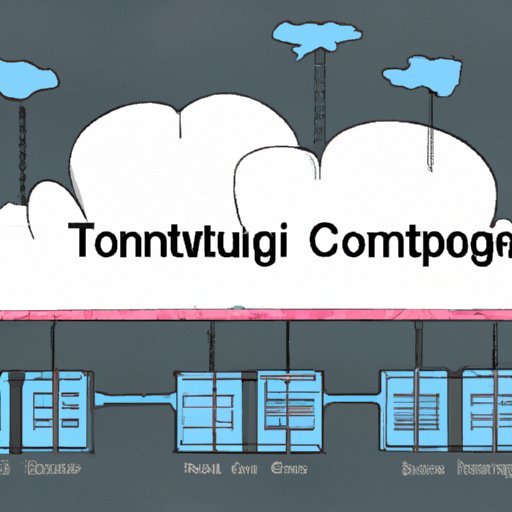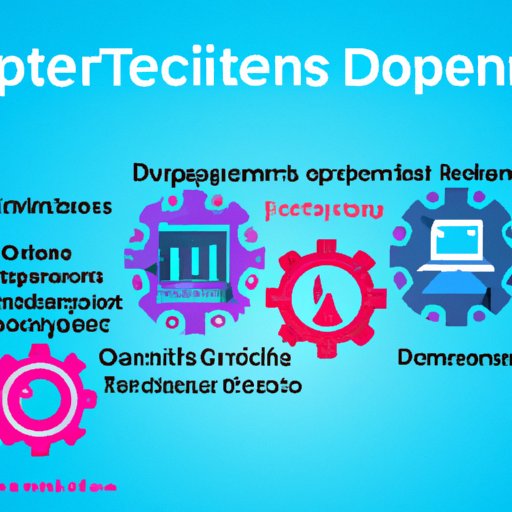Introduction
Container technology has quickly become a critical component in modern software development, enabling organizations to build, deploy, and manage applications with ease and efficiency. But what exactly is container technology? How does it work? And most importantly, why should enterprises consider using it? This article will explore these questions and provide an overview of the benefits, security implications, and disruptive impact of container technology on the cloud computing landscape.
Beginner’s Guide to Container Technology
At its core, container technology is a form of operating system virtualization that allows developers to package application code and all its dependencies into a single unit for easy management and deployment. This “container” can then be run across multiple environments, from local development machines to production servers, without any modification or compatibility issues.
There are two main types of containers: lightweight and heavyweight. Lightweight containers, such as Docker, are designed to be small and fast, making them ideal for deploying multiple services and applications on a single server. Heavyweight containers, such as LXC, offer more flexibility and scalability but come with a larger memory footprint.
So how does containerization work? Each container is isolated from the host operating system and other containers running on the same system. This isolation ensures that each container runs its own independent version of the OS and has access only to its own resources. Containers also share the same kernel, allowing them to communicate with each other without the need for additional networking configuration.

Exploring the Benefits of Container Technology
One of the key advantages of using container technology is increased efficiency. By packaging all the necessary components into a single, self-contained unit, containers make it easier for developers to quickly deploy and scale applications. This eliminates the need for manual configuration and reduces the amount of time spent troubleshooting.
Another benefit of container technology is flexible deployment. Containers can be deployed anywhere—from a laptop to a data center—without any compatibility issues. This makes it easier for developers to move applications between different environments and test new features in production.
Finally, container technology offers improved security. Since containers are isolated from their host environment, they are less vulnerable to malicious attacks. Additionally, since containers are stateless, they don’t store any data, making them even more secure.
Securing Your Enterprise with Container Technology
In order to ensure that your enterprise is secure when using container technology, it’s important to identify any vulnerable components and implement security protocols. This includes scanning images for known vulnerabilities and regularly monitoring containers for suspicious activity.
It’s also important to use container images that have been verified by a trusted source. Images from untrusted sources may contain malicious code or backdoors that could put your enterprise at risk.
Finally, it’s important to keep your containers updated with the latest security patches. Regularly updating containers will help ensure that your applications remain secure.

How Container Technology is Disrupting the Cloud Computing Landscape
Container technology is having a significant impact on the cloud computing landscape. Automation and orchestration tools, such as Kubernetes and Docker Swarm, enable developers to quickly deploy and scale applications without manual intervention. This helps to reduce costs and improve the efficiency of cloud computing operations.
Container technology is also streamlining DevOps processes. By automating the deployment of applications, containers make it easier for developers to collaborate and quickly iterate on new ideas.
Finally, container technology is offering cost savings. By eliminating the need for manual configuration and reducing the number of servers required to run an application, containers can help to reduce operational costs.
What is Containerization and Why Does it Matter?
In order to understand the benefits of container technology, it’s important to first understand what microservices are and why they are important. Microservices are small, independent services that communicate with each other via APIs. This makes it easier for developers to quickly build and deploy applications without having to worry about underlying infrastructure.
The primary reason to use containerization is to maximize portability. Since containers are self-contained units, they can easily be moved between different environments without any compatibility issues. Additionally, containers allow developers to isolate services and scale them independently, making it easier to manage complex applications.
However, there are some potential pitfalls to using containerization. For example, managing multiple containers can be difficult and resource-intensive. Additionally, if a container becomes compromised, it can affect other containers running on the same system.

An Overview of Container Technology and Its Impact on DevOps
Container technology is revolutionizing DevOps by accelerating application delivery and improving collaboration. By automating the deployment of applications, containers make it easier for developers to quickly get feedback and iterate on new ideas.
Container technology also enables teams to collaborate more effectively. By providing a consistent environment for developers to work in, containers make it easier for teams to share information and coordinate efforts.
Finally, container technology is enhancing agility. By allowing developers to quickly deploy and scale applications, containers make it easier for organizations to respond to changing customer needs and market conditions.
Conclusion
Container technology is quickly becoming an essential part of modern software development. It offers increased efficiency, flexible deployment, improved security, and cost savings. Additionally, container technology is disrupting the cloud computing landscape by automating application delivery and streamlining DevOps processes.
By understanding the benefits and potential pitfalls of container technology, organizations can better leverage this powerful technology to drive innovation and stay ahead of the competition.
(Note: Is this article not meeting your expectations? Do you have knowledge or insights to share? Unlock new opportunities and expand your reach by joining our authors team. Click Registration to join us and share your expertise with our readers.)
